Yesterday, in a post about some long term housing data, I added an M3 chart that got a bit of attention. For those who don’t know, M3 is a broad measure of money in the Australian economy including all types of deposits in the lending institutions. As “loans create deposits” M3 is a good proxy for a measure of the amount of banking credit that is been created. You can see from the chart that over the latest 20 years Australia has been on a credit binge, something that the MB team cover constantly.
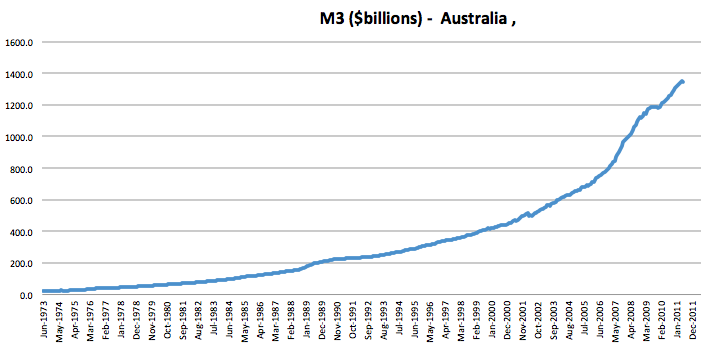
What makes that chart more interesting is that it is almost a mirror image of the inflation data over the same period.
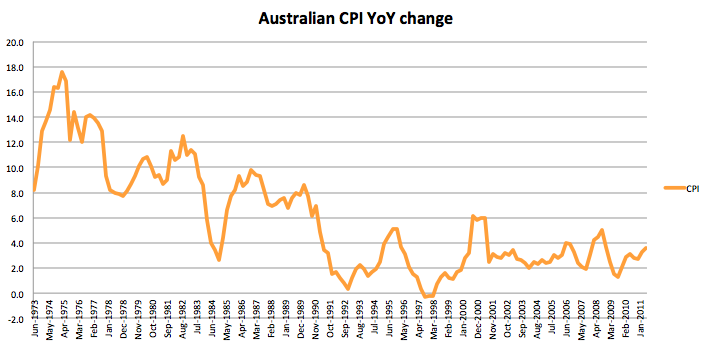
It should now not be a surprise to anyone why Australian housing has performed so well over the last 4 decades.
But there is another side to all of this credit and that is the underlying asset values and income that support it. To understand that we need to have a look at RBA’s housing finance data (B21). This data is quarterly and is badly lagged. Yesterday’s release was for March.
Firstly the caveats.
- Data are seasonally adjusted, unless otherwise noted.
- Debt refers to total household debt as calculated by the RBA and is the sum of housing and other personal debt, including securitised debt. Debt excludes debt owed by unincorporated enterprises. These data are adjusted for the effects of breaks in the series.
- Assets refers to the total of dwelling assets, consumer durables and financial assets as reported in statistical table B20.
- ‘Financial assets’ includes financial assets of unincorporated enterprises and is not seasonally adjusted. Financial assets data are derived from ABS Cat No 5232.0, Table 20. The sectoral classification is on a national accounts basis and differs slightly from that in the preceding tables.
- The household sector includes unincorporated enterprises and non-profit institutions serving households. Identified claims between transactors in the same sector are excluded. The data were upgraded in 2009 to comply with SNA08 standards and are only available back to June 1988.
- ‘Debt to assets’ refers to the ratio of total household debt to total household assets.
- ‘Housing debt to housing assets’ refers to the ratio of housing debt (including securitisations) to total dwelling assets.
- For the purpose of calculating ‘Assets to disposable income’ and ‘financial assets to disposable income’, ‘disposable income’ includes gross mixed income earned by unincorporated enterprises and is measured before the deduction of net interest payments. Data on disposable income are sourced from the quarterly national accounts (ABS Cat No 5206.0) and are reported in annual terms.
- ‘Debt to disposable income’ is the ratio of total household debt to household disposable income. ‘Debt to disposable income – Housing’ is the ratio of housing debt (including securitisations) to household disposable income. ‘Debt to disposable income – of which: Owner-occupier’ is the ratio of owner-occupier housing debt (including securitisations) to household disposable income.
- ‘Interest payments to disposable income’ is the ratio of interest payments on housing and other personal debt to disposable income. From 1993, these data are calculated by the RBA using average interest rates on outstanding housing and other personal debt. Interest payments prior to 1993 are sourced from unpublished ABS data.
- ‘Interest payments to disposable income – Housing’ is the ratio of interest payments made on housing loans to disposable income.
- For the purpose of calculating the ‘Debt to disposable income’ and ‘Interest payments to disposable income’ ratios, disposable income excludes gross mixed income earned by unincorporated enterprises and is measured before the deduction of interest payments. Data are sourced from the quarterly national accounts. For the debt to disposable income ratio, data are reported in annual terms.
So basically these are broad comparisons of assets, incomes and interest payments that don’t take into account any sort of composition. The Unconventional Economist has previously done some work in this area which clearly shows that older cohort owns more of the assets, while the younger owns the debt. It is important to keep that in mind when analysing this data.
To the data then….
Firstly total debt to asset ratio.
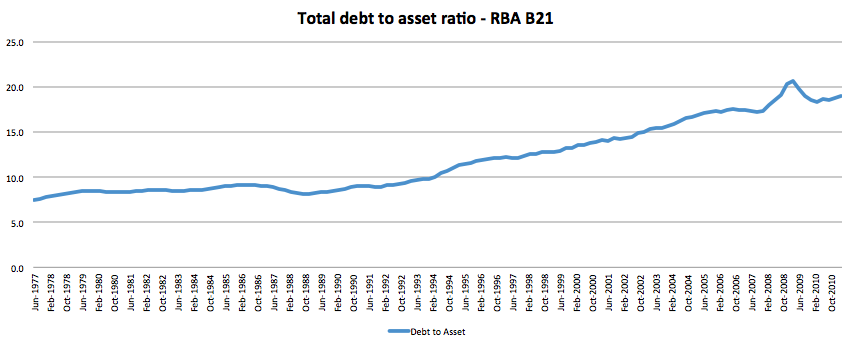
Most notably you can see the effect of the GFC where asset values fell before the re-ignition of credit via stimulus. You can also see that the ratio is now higher than it was before the GFC and continues to climb. I expect this to get worse in the next data release as housing prices continue to slide.
The housing debt to asset ratio data already clearly displays this trend.
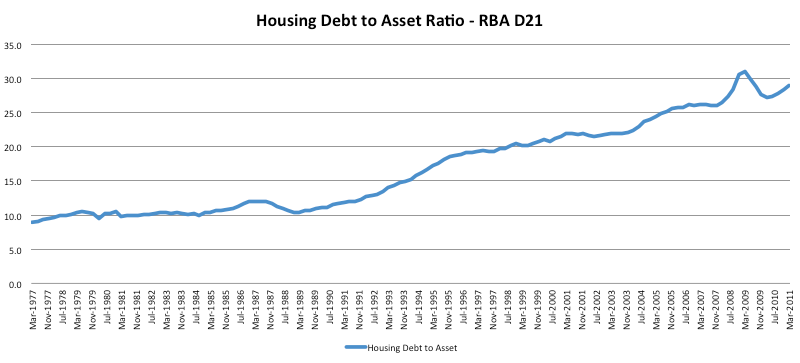
This data also brings up something I have mentioned previously a number of times. You can see in the post-GFC period that the debt to asset ratio was actually falling at a time when large amounts of high LVR debt issuance was occurring. This is because the rate of credit issuance was supporting the value of the underlying assets. Now that the rate of issuance has fallen the value of the assets have also fallen. This clearly shows the asset value-debt dependency that can be so dangerous to an economy after a credit boom because it can quickly lead to negative equity for new entrants.
The asset to income data tells a similar story, with financial assets relatively flat but housing falling. It must be noted that this data is preceding the latest stock market turmoil.
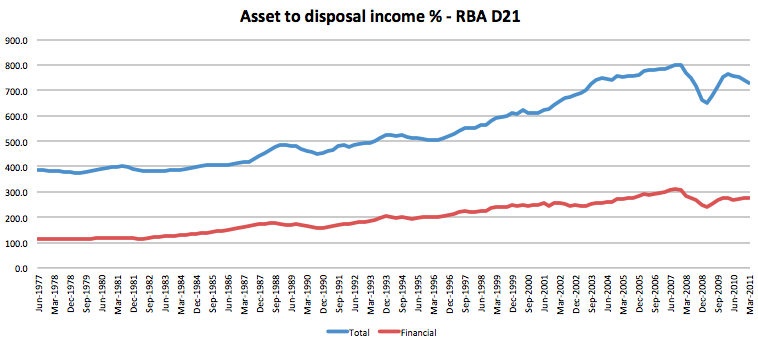
Finally we have interest payments to disposable income which clearly show the effects of interest rates on top of the long term trend of debt growth.
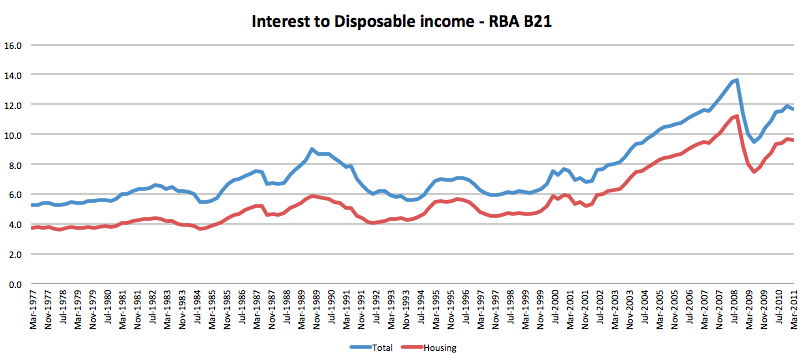
So, it seems that every chart based on the B21 data is heading in the wrong direction. Debt in proportion to assets continues to grow even at a time of strong wage growth, while housing asset values fall on the back of slowing credit growth. Under the current circumstances I cannot see either of these trends changing any time soon, in fact given the current economic turmoil across the globe I expect them to accelerate.
The big question now is if and/or when we will see some counter-action from the RBA to reverse these trends. I’m not holding my breath on that one.